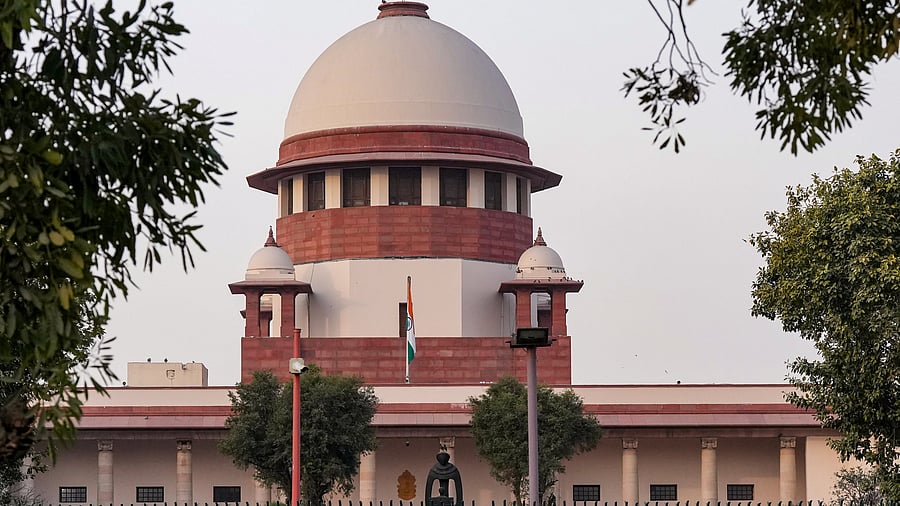
The Supreme Court of India.
Credit: PTI File Photo
New Delhi: The Supreme Court on Tuesday held that not all privately owned resources can be acquired by the State, which, however, can stake claims over resources that are material and are held by the community, for public good.
A nine-judge Constitution bench led by Chief Justice of India D Y Chandrachud by a majority view held that Justice V Krishna Iyer's previous decisions which declared that all privately owned resources can be acquired by the State, was motivated by a particular economic and socialist ideology.
"The direct question referred to this bench is whether the phrase ‘material resources of the community’ used in Article 39(b) of the Constitution includes privately owned resources. Theoretically, the answer is yes, the phrase may include privately owned resources," the majority view said.
However, this court is unable to subscribe to the expansive view adopted in the minority judgement authored by Justice Krishna Iyer in State of Karnataka Vs Ranganatha Reddy (1977) and subsequently relied on by this court in Sanjeev Coke Manufacturing Co Vs Bharat Coking Coal Ltd (1983), it added.
"Not every resource owned by an individual can be considered a ‘material resource of the community’ merely because it meets the qualifier of ‘material needs’," the bench said.
The CJI, along with six other judges, said it is incorrect to hold that all private properties would belong to community resources.
He held previous ruling by Justice Iyer was rooted in particular economic ideology.
The CJI said the role of this court was not to lay down economic policy. He noted people have voted for the government, which adopted varied economic policy.
It would undermine the very principle of the Constitution if all resources held by the individuals are considered as material resources of the community.
The majority judgment was authored by the CJI Chandrachud, for himself and Justices Hrishikesh Roy, J B Pardiwala, Manoj Misra, Rajesh Bindal, Satish Chandra Sharma and Augustine George Masih.
Two other judges in the bench Justices B V Nagarathna and Sudhanshu Dhulia, however, partially differed with the CJI's majority judgment.
Justice Nagarathna termed the CJI's comments on Justice Krishna Iyer as "unwarranted and unjustified".
Justice Dhulia recorded his "strong disapproval" on remarks made on Justice Krishna Iyer doctrine, saying "This criticism is harsh and could have been avoided".
The question before the bench was whether privately owned property are covered under the ambit of “material resources of the community”, under Article 39(b) of the Constitution.
In its answer, the majority view said, "The inquiry about whether the resource in question falls within the ambit of Article 39(b) must be context-specific and subject to a non-exhaustive list of factors such as the nature of the resource and its characteristics; the impact of the resource on the well-being of the community; the scarcity of the resource; and the consequences of such a resource being concentrated in the hands of private players".
The bench also pointed out the public trust doctrine, which provided the State holds all
natural resources as a trustee of the public, evolved by this court may also help identify resources which fall within the ambit of the phrase “material resource of the community”.
With regard to term ‘distribution’, the bench said it has a wide connotation as the various forms of distribution which can be adopted by the state cannot be exhaustively detailed. However, it may include the vesting of the concerned resources in the state or nationalisation. In the specific case, the court must determine whether the distribution ‘subserves the common good’, it added.
"There may exist private ownership of forests, ponds, fragile areas,wetlands and resource-bearing lands. Similarly, resources like spectrum, airwaves, natural gas, mines and minerals, which are scarce and finite, may sometimes be within private control. However, as the community has a vital interest in the retention of the character of these resources, they fall within the ambit of the expression “material resources of the community”," the bench said.
The court disagreed with previous judgments, which were based on socialist theme and had then held that government can direct its policies to redistribute community's material resources, including privately owned properties, to subserve common good and to develop an egalitarian society.
The court noted there has been a shift towards socialist economy in 1960s and 70s, but the focus shifted to market oriented economy since 1990s.
It said the country's trajectory of economy eschewed any particular type of economy but meant to meet emerging challenges of a developing country.
The court pointed out adoption of dynamic economic policy through the last 30-odd years has made India the fastest growing economy in the world.
Article 39(b) enjoined the State to endeavor “that the ownership and control of material resources of the community, are so distributed as best to subserve the common good”.
The issue also involves interpretation of Article 39(c) which says “the operation of the economic system does not result in the concentration of wealth and means of production to the common detriment”.
The case arose out of law in Maharashtra that allows a state undertaking (MHADA – Maharashtra Housing and Development Authority) to acquire certain private properties under Chapter VIII-A of the MHADA Act 1976. The acquisition of the private properties could be for better preservation of the said property/building or for reconstruction/repairs etc.
The petitioners led by Property Owners Association argued that “material resources” of a community does not include private resources and Article 39(b) talks only of public resources or national resources as only these resources can be redistributed by the State to subserve the greatest common good.
The Union government and MHADA, on the other hand, argued against a restrictive interpretation of Article 39(b).
They contended that the principle of ‘common good’ and the ideals of the Constitution, which is to ensure ‘distributive justice’ and achieve socialist egalitarian goals of distribution of resources would stand defeated if privately held properties are kept outside the ambit of Article 39(b).
